Centrifugal compressors are one of the most commonly used gas compression systems across a variety of industries. For a centrifugal compressor, the impeller and diffuser are the two most critical components in achieving high-stage performance and good flow range.
Therefore, they establish the “baseline” efficiency of the compressor, so the ability to design these components with high efficiency is very important.
Over the years ADT has been involved in thousands of compressor designs across all different specific speeds and applications and has developed considerable fluid dynamic knowledge to design high-performance compressors systematically. Here is a summary of some of the main adverse fluid phenomena that cause drops in performances in these critical compressor components.
Compressor Design Process
The first step in the design of any compressor is to identify the required specific speed regime of the compressor. This will dictate the meridional shape and the pump's general flow direction. For example, a low specific speed compressor is likely to be a radial or centrifugal type. In contrast, a high specific speed compressor is likely to be of mixed flow or axial type. From the required specific speed, we can identify the main flow phenomena and loss mechanisms dominant in that particular range (see figure below). For example, leakage and secondary flow effects are more dominant in lower ranges, whereas profile/shock losses and corner separation in diffusers take priority in the higher ranges.
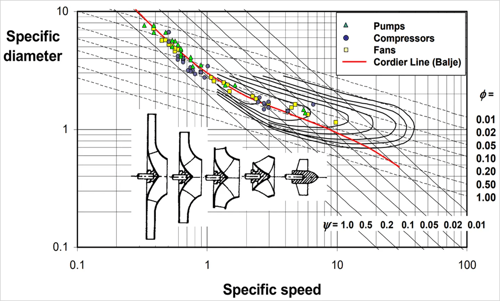
From the information above we can use design tools and 3D CFD to investigate our compressor designs; what follows are a set of principal design guidelines based on the fluid dynamics considerations of reducing dominant flow losses for a given impeller / diffuser.
Reduction of Secondary Flow in Industrial Radial Impellers
The Issue
For medium-specific speed centrifugal compressors, secondary flows in the impeller are well acknowledged to drive the high-loss fluids in the viscous layer toward the shroud/suction surface corner region. The secondary flow phenomena have important detrimental effects on the efficiency and stability of the impeller. In addition to this, it has a dominating influence on the generation of the exit flow non-uniformity (so-called “jet-wake” flow pattern) and affects the performance and stability of the downstream diffuser.
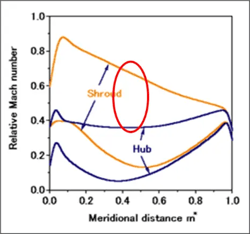
The Solution
An appropriate choice of blade loading can help reduce the pressure jump in the aft part of the blade at the shroud and increase it in the forepart, and vice versa for the hub, which helps to reduce ΔCp that is driving the secondary flow. Reducing these gradients of reduced static pressure makes it possible to eliminate secondary flows on the suction surface, resulting in a much more uniform exit flow from the impeller.
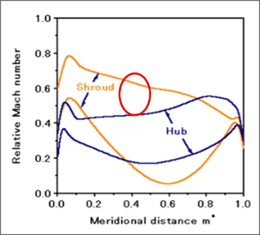
Shock Control in Transonic Centrifugal Compressors
The issue
For high-specific speed centrifugal compressors, shocks are the dominant source of loss, and there is also a complex interaction with the tip clearance vortex. So the type of loading that needs to be specified has to control the shock losses.
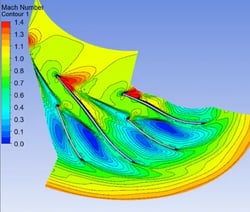
The Solution
The optimum blade loading will reduce the pressure jump across the inducer and as a result, will reduce the strength of the shock as well as the tip clearance vortex, and therefore a weaker interaction between the two.
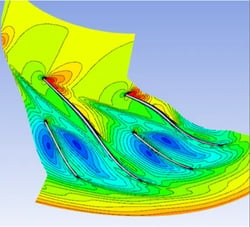
Corner Separation Control in Vaned Diffusers
The Issue
For high work coefficient centrifugal compressors, corner separation in vaned diffusers happens when the low momentum fluid at the hub suction surface corner hits the strong positive pressure gradient. So, the optimization of blade shape is extremely important to avoid this large-scale flow separation along the hub suction surface corner.
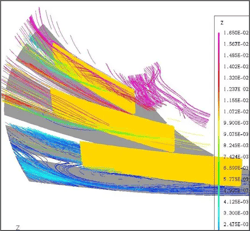
The Solution
The optimum blade loading diffuses the flow rapidly and reduces the strong pressure gradient. At the shroud, it results in strong secondary flows on the suction surface moving low-momentum fluids from the shroud to the hub and then to the middle of the passage. So, there is no accumulation of low momentum fluid at the endwall, and thus the corner separation can be totally suppressed.
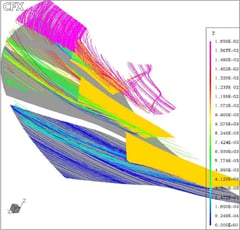
Webinar on Optimum Blade Loading in Centrifugal Compressors
In this webinar, we demonstrate how compressor designers can exploit their knowledge of aerodynamics to directly address specific flow phenomena in compressors using the inverse design approach. This approach leads to a natural expansion of the explored design space as the designer is pushed to operate outside his comfort zone.
- Learn how to use the knowledge of flow physics gained from CFD and experiments to arrive at the optimum blade loading for compressors,
- Discover the optimum blade loading for controlling a particular flow phenomenon in compressor impellers (e.g. secondary flow and shock control),
- Understand how to target critical sources of loss mechanisms for your particular compressor and thus enhance its performance.
Geet Nautiyal
Geet Nautiyal is a Turbomachinery Application Engineer at Advanced Design Technology, focusing on design, marketing and customer support aspects.
View All Articles











Share This Post